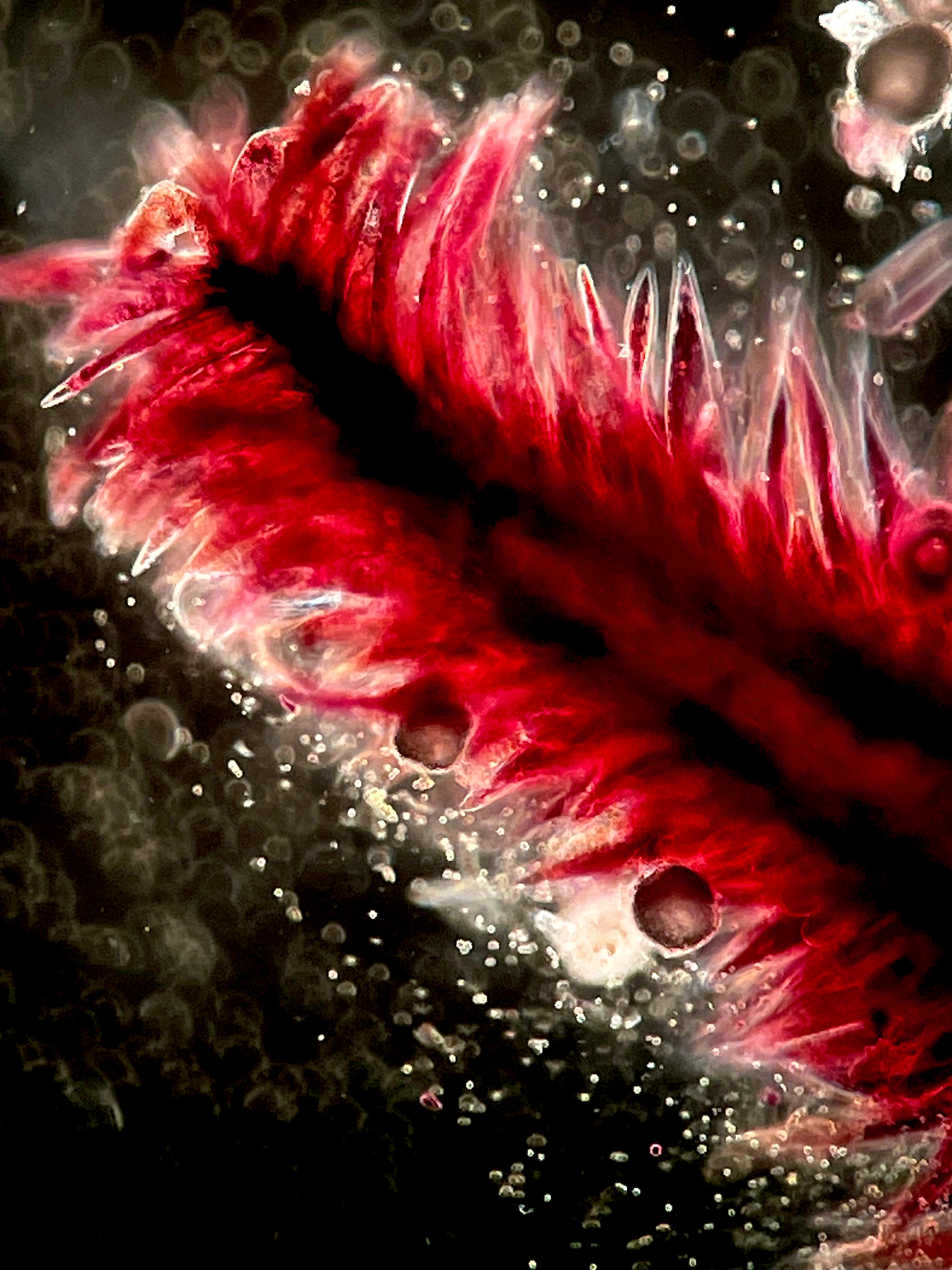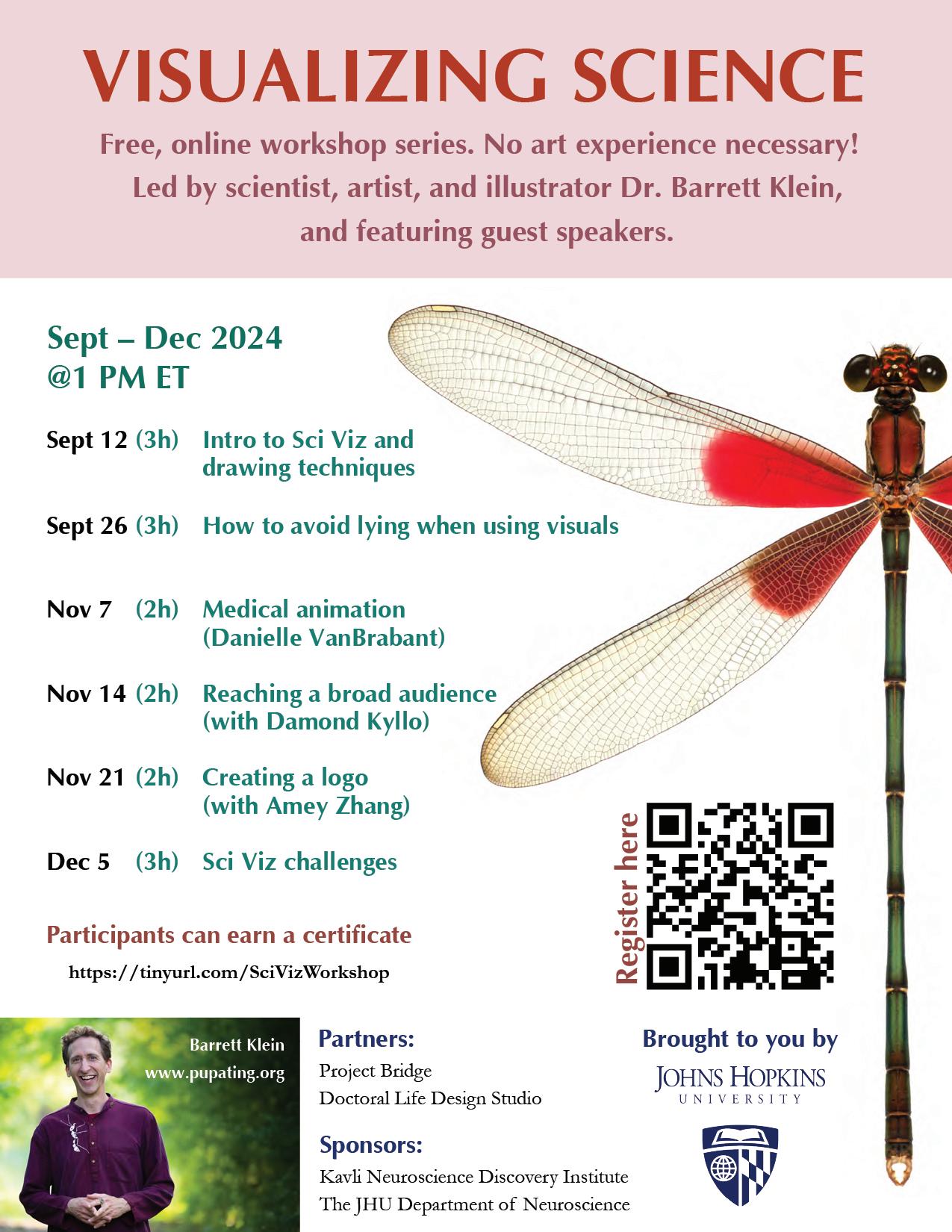We’re back for another year of Project Bridge SciComm’s Charm City Science, your quarterly guide to local science news and events. At Project Bridge, our mission is to connect scientists with the broader community, and help make science accessible to everyone. If you have questions, like what we do, or want to get involved, let us know! You can reach out to us via email, or check out our social media accounts. Our contact info is on the back cover of this zine, along with QR code that you can scan for links to some of our projects - including the online version of this zine, with links to more information for all of the events. You can read it at linktr.ee/pbscicomm
If you like this zine, you may be interested in some of the workshops and programs we will be hosting in the upcoming year - including our ongoing Science Visualization Workshop Series! This series is geared towards working scientists, and is free and open to all researchers (regardless of institutional affiliation). The upcoming workshops, led by Dr. Barett Klein with various guests, will focus on science illustration, communicating and distributing one’s artwork, and other interesting topics. Workshops are held via zoomregister at tinyurl.com/SciVizWorkshop for links and more information.
You also won’t want to miss Project Bridge’s Science Gong Show: Halloween Edition- that’s coming up on October 30th, from 7-9 PM at Peabody Heights Brewery. You can watch researchers try to give a five minute talk about their work without using any technical jargon - and drown them out with gongs if they mess up!
Hope to see you there, and enjoy spooky season
Jackson Mace, PhD Student, JHU-SOM Cellular and Molecular Medicine
Malka Svei, PhD Student, JHU-SOM Neuroscience Co-Chairs, Project Bridge Science Communication Committee
3775-year-old wood burial supports “wood vaulting” as a durable carbon removal method
Earlier this fall, Hurricane Helene hit North Carolina with record breaking floods - destroying housing and infrastructure, and killing more people than any storm in the US since Hurricane Katrina. Weather disasters like Helene are occurring more frequently as temperatures rise. To reverse this pattern, scientists are searching for ways to decrease the major cause of climate change: excess carbon dioxide emitted by burning fossil fuels. Plants trap carbon as they grow, but release most of it as they decay. An ancient tree recently discovered outside Montreal suggests a way to keep that carbon out of the atmosphere. University of Maryland researcher Ning Zeng and collaborators analyzed the 3700 year old wood, which had been buried two meters deep in clay, and found that it had lost hardly any carbon in that time. The authors explain that wood could be intentionally buried in a similar way sustainably and at a relatively low cost - potentially offsetting a significant percentage of global carbon emissions.
Ning Zeng et al., 3775-year-old wood burial supports “wood vaulting” as a durable carbon removal method.Science385,1454-1459(2024).DOI:10.1126/ science.adm8133
Towards transforming malaria vector surveillance using VectorBrain: a novel convolutional neural network for mosquito species, sex, and abdomen status identifications
Malaria is a major health concern worldwide, and tracking the movement of potentially disease carrying mosquitos is a key component in prevention. Details like species, sex, and feeding and breeding patterns provide important information about risk factors - for example, only female mosquitos bite, but the presence of many male mosquitos in one location indicates that the insects are actively breeding nearby. Deming Li and colleagues at Johns Hopkins have designed an artificial neural network that can automatically extract these details from photos. The network, Vector Brain, is highly accurate and can be run on a basic mobile device, making it a valuable tool for public health in malaria prone regions.
Li, D., Hegde, S., Sunil Kumar, A. et al. Towards transforming malaria vector surveillance using VectorBrain: a novel convolutional neural network for mosquito species, sex, and abdomen status identifications. Scientific Reports 14, 23647 (2024). https://doi.org/10.1038/s41598-024-71856-8
Science in the City: A Quarterly Calendar of Events
All events are located in Baltimore City. Events are free of charge unless otherwise noted. * we now have a google calendar! subscribe here*
↺ = recurring event, check location website for the most up to date schedule
✎= Registration required.
Kids and Families:
Build a Constellation
Tuesday, Oct 22, 3:00 PM-4:00 PM
Pratt Library Hamilton Branch. 5910 Harford Road; Baltimore; MD 21214
Build a constellation using pipe cleaners and beads.
Bat walk with Baltimore Green Space
Thursday, Oct 24, 6:15 PM-7:15 PM
Masonville Cove; 1000 Frankfurst Ave
Halloween Costumes welcome Bat walk with Baltimore Green Space
Wednesday, Oct 30, 6:15 PM-7:15 PM
Masonville Cove; 1000 Frankfurst Ave
Halloween Costumes welcome Kids Chromatography (Ages 8 - 14)✎
Saturday, Nov 02, 5:00 PM-6:00 PM
BUGGS; 101 North Haven Street Suite #105 14.64 per person
STEM Day: The Air in There (Air Cannon)
Thursday, Nov 07, 3:00 PM-4:00 PM
5108 Roland Avenue; Baltimore; MD 21210
Scientists do experiments in wind chambers to understand how air behaves at different speeds. We’ll design an air cannon based on the PBSkids show SciGirls. Solar Bugs (Kids 6-11)
Saturday, Nov 09, 2:30 AM-3:30 AM
Pratt Library Hampden Branch. 3641 Falls Road Baltimore; MD 21211
Learn about solar energy while creating your own solar-powered bug!
Raptor Chat✎
Saturday, Nov 16, 1:00 PM-3:00 PM
Carrie Murray Nature Center; 1901 Ridgetop Road* Nature for Kids
Saturday, Nov 16, 10:00 AM-11:00 AM
Masonville Cove; 1000 Frankfurst Ave
Dinovember Dig (Kids 2+)
Friday, Nov 22, 11:00 AM-12:00 PM
Pratt Library Hampden Branch. 3641 Falls Road Baltimore; MD 21211
Critter Tunes & Tales with Wildlife Adventures
Thursday, Dec 05, 10:30 AM
400 E. 33rd Street; Baltimore; MD 21218
Join us at the library for "Critter Tunes & Tales!" This program highlights songs and fingerplays designed for the young child along with our friendliest animal friends to touch and hold.
this series is designed for working scientists and is open to all researchers regardless of institutional affiliation
Calendar of Events : Continued
Mad Science: Che-Mystery
Thursday, Dec 05, 3:00 PM-4:00 PM
3203 W. North Avenue; Baltimore; MD 21216
Explore chemistry & learn how to handle labware while you grow a crazy crystal garden and concoct your own soda pop!
Science Heroes: Break the Ice!
Monday, Dec 16, 10:30 AM
1251 Light Street; Baltimore; MD 21230
Join us on a fun and interactive learning adventure that introduces preschoolers to solids, liquids, & gases
Nature/Volunteering:
Bird Banding↺
Thursday, Oct 24, 8:00 AM-10:30 AM
(Every friday - saturday; select thursdays; from 10/24 -12/7 (except last week of november))
Masonville Cove; 1000 Frankfurst Ave
Intro to Birdwatching for Teens
Thursday, Oct 24, 3:30 PM-5:30 PM
400 E. 33rd Street; Baltimore; MD 21218
Discover the fascinating world of birdwatching with our Intro to Birdwatching Program!
Family Nature Hike↺ ✎
Saturday, Nov 02, 10:00 AM-12:00 PM
Saturday, Dec 07, 10:00 AM-12:00 PM
Carrie Murray Nature Center; 1901 Ridgetop Road*
Every first Saturday. Come prepared in walking shoes
Clean-Up in Farring Baybrook Park ✎
Saturday, Nov 02, 9:00 AM-12:00 PM
Farring-Baybrook Recreation Center; 4501 Fairing Ct.
Kids under 18 must be accompanied by an adult and have waiver signed by a guardian
Community Shoreline Clean-Up ✎
Saturday, Nov 09, 1:30 PM-2:30 PM
Masonville Cove; 1000 Frankfurst Ave
Wednesday Walk: Biology of Fall↺ ✎
Wednesday, Nov 20, 12:00 PM-1:00 PM
Cylburn Arboretum; 4915 greenspring ave
Suggested donation $5; (“member registration” to register free).
Treekeepers Plus: Project Management✎
Wednesday, Dec 11, 6:00 PM-8:00 PM
Online - register at treebaltimore.org/TreeKeepers
Treekeepers: Introduction to Pruning & Pruning Field Session ✎
Saturday, Dec 14, 10:00 AM-12:30 PM
TBD - register at treebaltimore.org/TreeKeepers for info
Treekeepers Plus: Tree Selection ✎
Wednesday, Dec 18, 7:00 PM-9:00 PM
Online - register at treebaltimore.org/TreeKeepers
Reflections and Intention Hike ✎
Saturday, Dec 28, 10:00 AM-12:00 PM
Carrie Murry Nature Center; 1901 Ridgetop Road*
Dress Warmly
Workshops/Activities:
Agar Art Workshop
Saturday, Oct 26, 10:00 AM-2:00 PM
BUGGS; 101 North Haven Street Suite #105
Drop in any time 10-2. $12.50 per person
Water Quality/ Climate Change Science (a citizen science opportunity) ✎
Saturday, Oct 26, 1:30 PM-3:00 PM
Masonville Cove; 1000 Frankfurst Ave
The Science Gong Show: Halloween Edition!
Wednesday, October 30, 7:00 - 9:00 PM
Peabody Heights Brewery, 401 East 30th Street
Fish Dissection Workshop✎
Friday, Nov 08, 6:30 PM-8:30 PM
701 East Pratt Street Baltimore
Come learn about marine anatomy with the Zohar Lab! Ages 8+ welcome Mammals of Masonville (1)✎
Saturday, Nov 09, 10:00 AM-12:00 PM
Masonville Cove; 1000 Frankfurst Ave
Wilderness Safety and Survival Training ✎
Saturday, Nov 16, 8:00 AM-3:00 PM
Carrie Murray Nature Center; 1901 Ridgetop Road
See Carrie Murray Nature Center website for required supplies Mammals of Masonville (2)✎
Saturday, Nov 16, 10:00 AM-11:30 AM
Masonville Cove; 1000 Frankfurst Ave
Water Quality/ Climate Change Science (a citizen science opportunity)✎
Saturday, Nov 23, 1:30 PM-3:00 PM
Masonville Cove; 1000 Frankfurst Ave
Talks/Lectures:
Book Talk: Black Lives - Great Minds of Scienceby Tonya Bolden✎
Wednesday, Oct 30, 4:00 PM-5:00 PM
Pratt Library Cherry Hill Branch; 606 Cherry Hill Rd
The Hidden History in Cylburn's Forest ✎
Friday, Nov 15, 5:00 PM-6:00 PM
Cylburn Arboretum; 4915 greenspring ave
$ 7.18 per person
*call the Carrie Murray Nature Center at (410) 396-0808 for more info & help registering
The image on the front of this zine is a stigma, a reproductive organ found at the tip of the disc florets that form the middle part of a sunflower. We're using a nearly 200-yearold technique called darkfield microscopy, which improves the contrast of an image by only allowing light to reach the eyepiece if it has been scattered by the sample. Darkfield imparts this image with a black background, highlights small objects like pollen grains, and gives the tendrils of the stigma a ghostly glow. However, the pink color is all-natural and was a complete surprise!
Katie Shy provided the sample. Martin Yepes Trujillo configured the microscope and edited the image. Both contributed to slide preparation and image acquisition. The picture was taken with a phone camera held up to the eyepiece of a Zeiss Axioskop, with the sample magnified 100x
















